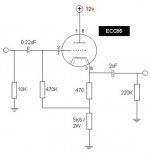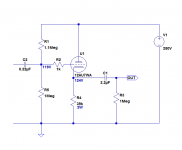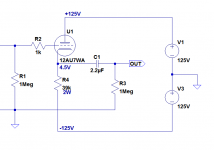Hello guys,
I want to build a tube buffer and put it between the CD and the Amp.
Although i dont want to tease the DAC of the CD.
I would like to put the tubes in the rca output of my CD and in my Amp rca's
How can i do that?
Do i neet some adjustmants when i put the lin in of my tube buffer to my RCA of my CD?
Thank you
I want to build a tube buffer and put it between the CD and the Amp.
Although i dont want to tease the DAC of the CD.
I would like to put the tubes in the rca output of my CD and in my Amp rca's
How can i do that?
Do i neet some adjustmants when i put the lin in of my tube buffer to my RCA of my CD?
Thank you
Hi,
you'll find plenty of information in this forum using "search", e.g.
http://www.diyaudio.com/forums/tubes-valves/234294-tube-buffer-6n1p-ev.html
Marcus
you'll find plenty of information in this forum using "search", e.g.
http://www.diyaudio.com/forums/tubes-valves/234294-tube-buffer-6n1p-ev.html
Marcus
I want to build a tube buffer and put it between the CD and the Amp.
You don't need any gain, so use a single tube cathode follower buffer.
Probably you can find a pcb on ebay for this.
http://www.ebay.com/itm/Audio-Hifi-...547098?hash=item3aac2a281a:g:8lcAAOSwAvJXA6x1
http://www.ebay.com/itm/DC12V-Audio...733271?hash=item3f71b69ed7:g:3pMAAOSw2xRYV2Jl
http://www.ebay.com/itm/AC-12V-6J1-...id=100005&rk=3&rkt=6&mehot=pp&sd=222151245540
Last edited:
IMHO buffers of this sort are filters. If you like what the filter does, fine. But if you gain something you'll probably lose something too. It's a trade off.
Cheers, Steve
Cheers, Steve
I can't see why you need that. The purpose of a "buffer" is to lower the output impedance of the source to improve driving capabilities. Any modern CD player has an output impedance wich is only a fraction (1/10 to 1/100) of a tube cathode follower, thus by adding a tube stage you can only degrade the performances. Needless extra electronics = extra coloration, but maybe that's what you're looking for ?
I can't see why you need that. The purpose of a "buffer" is to lower the output impedance of the source to improve driving capabilities. Any modern CD player has an output impedance wich is only a fraction (1/10 to 1/100) of a tube cathode follower, thus by adding a tube stage you can only degrade the performances. Needless extra electronics = extra coloration, but maybe that's what you're looking for ?
Another purpose is, to minimize audible distortions caused by non-linear input resistance of a solid state amp that also reflects the load!
Just one tube, or one JFET, or one MOSFET stage improves the sound dramatically! Especially a tube that has no such non-linear capacitances and is less frequency-dependent in an audio band.
Thank you very much for your replies.
Im looking for a musical fidelity from Ebay or
to build my own a tube buffer!
Do you have any schematics about it or for musical fidelity x-10d?
I would like to warm the sound with the tubes without adding any gain!
If you have any informations or schematic i would be grateful!
Im a beginner to this so...i can use any help!
Thanks
Im looking for a musical fidelity from Ebay or
to build my own a tube buffer!
Do you have any schematics about it or for musical fidelity x-10d?
I would like to warm the sound with the tubes without adding any gain!
If you have any informations or schematic i would be grateful!
Im a beginner to this so...i can use any help!
Thanks
About tube buffers
What do you think of musical fidelity x-10d ?
I want to build one of my own or to buy a cheap buffer and change capasitors etc.
If you know anything about it !
I could use some opinions!
Thanks
What do you think of musical fidelity x-10d ?
I want to build one of my own or to buy a cheap buffer and change capasitors etc.
If you know anything about it !
I could use some opinions!
Thanks
Hi
Where do you find such a bad amplifier ? 😕
If so better to change the amplifier.
Jacques
Wavebourn said:Another purpose is, to minimize audible distortions caused by non-linear input resistance of a solid state amp that also reflects the load!
Where do you find such a bad amplifier ? 😕
If so better to change the amplifier.
Jacques
We're in the Tubes/Valves section of diyAudio, so I guess it would make sense to mention that if you really want to make a line level buffer, and you want to use a tube, then great! Here's my $0.02 worth...
Build a simple, regulated 250VDC 10mA supply, with a 12VDC 0.5A heater supply.
There are tubes that work well with low plate current and low heater current, and can still work with a grid bias of greater than 2V (plate-cathode). ECC82/12AU7 is one, and you can get them fairly cheap. Others are the Russian 6N6P or the 6SN7 (6N8C), but those require more heater and plate current.
Make a cathode follower. Use a good quality output capacitor.
Maybe something like this? Just for a start... You could improve it by replacing R4 with a 3mA constant current sink.
--
Build a simple, regulated 250VDC 10mA supply, with a 12VDC 0.5A heater supply.
There are tubes that work well with low plate current and low heater current, and can still work with a grid bias of greater than 2V (plate-cathode). ECC82/12AU7 is one, and you can get them fairly cheap. Others are the Russian 6N6P or the 6SN7 (6N8C), but those require more heater and plate current.
Make a cathode follower. Use a good quality output capacitor.
Maybe something like this? Just for a start... You could improve it by replacing R4 with a 3mA constant current sink.
--
Attachments
Last edited:
There's someone who sells...
to someone who buy
🙄
+1
Leaving opamps where they are and to add a tube stage (often with too much gain) makes little sense except one does so because one can.
Making the chain shorter or replacing mediocre designed output stages for tubed ones can be beneficial when done right. If the signal supposedly is "metallic" and such adding a stage which makes this agreeable is less efficient than solving the problem at the root.
Last edited:
Your right Jean-Paul.
I have good experience with removing all the sand behind the dac, use passive volumcontrol/source switch and then to Se tube amp.
But thread starter will/can not modify his dac/cd player.
I have good experience with removing all the sand behind the dac, use passive volumcontrol/source switch and then to Se tube amp.
But thread starter will/can not modify his dac/cd player.
Hi
Where do you find such a bad amplifier ? 😕
If so better to change the amplifier.
For example, Blameless by you know whom... ;-)
He suddenly found that a volume pot distorts! However, later he found that it distorts due to non-linear input impedance of the amp... And wrote an article about that. 🙂
What happens when you add feedback by voltage to an amp? Right, it's linearity by voltage increases. What happens to the current gain?
Think... ;-)
Use a good quality output capacitor.
A 4.7 μF. metalized polypropylene part bypassed by a 0.47 μF. 716P series "orange drop" will be quite satisfactory. Somewhat better, but not especially cost effective, is to use a 0.33 μF. PPFX MultiCap in the bypass role.
Dear Winderson,
Here's my humble submission to the tube buffer pile:
https://wtfamps.wordpress.com/muchedumbre-3/
Simple 12AU7 cathode follower with power supply (tube rectified because why not).
Here's my humble submission to the tube buffer pile:
https://wtfamps.wordpress.com/muchedumbre-3/
Simple 12AU7 cathode follower with power supply (tube rectified because why not).
The heretical preamp
My favorite tube buffer, easy to build, cheap components, and simple as dirt if you build without the servo. Low enough THD to be considered transparent.
The power supply can be simplified down to a simple CRCRC without issue.
My favorite tube buffer, easy to build, cheap components, and simple as dirt if you build without the servo. Low enough THD to be considered transparent.
The power supply can be simplified down to a simple CRCRC without issue.
- Status
- Not open for further replies.
- Home
- Amplifiers
- Tubes / Valves
- Tube buffer between CD and amp!


